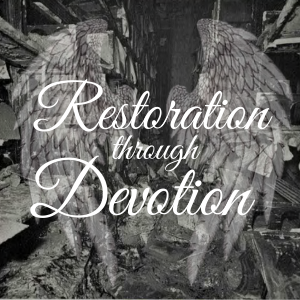Restoration through Devotion

This week, book shops and libraries across the UK are opening their doors to the public for the first time in three months.
The coronavirus pandemic has wreaked economic havoc across the nation, and the book industry has been affected as much as anyone. With bookstores and libraries forced to close, fairs cancelled and events postponed, book dealers have had to rely on digital sales and the devotion of their buyers to persevere through such obstacles.
Fortunately, such devotion is not lacking amongst book collectors.
This is not the first, nor the worst natural disaster to be faced by our industry. Throughout history libraries have fallen victim to unpredictable calamity, and time and again the response from the book-community is a defiant, rallying cry: ‘Save the Library! Protect the Book!’
After the devastating flood of the Arno in Florence in November 1966, hundreds of people travelled from across the world to assist in the relief efforts. These ‘mud angels’, as they became known, stayed for months rescuing and restoring damaged books and manuscripts, sweeping muddied floors and rebuilding the obliterated stacks.
A few weeks ago we published a Podcast on The Flood of Florence. This first-hand account was written by Mario M. Witt and published in our Spring 1967 issue, which was dedicated to the people of Florence.
We plan to include a new article on the flood of the Arno in our next issue, Autumn 2020, and as a preview we have included some images below (photographs by Peter Waters, a fellow ‘mud angel’)
The first shows the height of the mud against the entrance to the Biblioteca Nazionale Centrale, immediately after the flood swamping the cars on the street outside. The second image shows the internal damage to some of the books and manuscripts on the stacks inside the Biblioteca Nazionale. And the third image shows a train of volunteers rescuing materials form the Archivio di Sato, a challenge on the narrow, slippery stairs.
Many more images will be included along with the upcoming article in Autumn 2020.
More recently in 2019, Venice was submerged in the worst floods to strike the city for more than fifty years. As the waters rose, the tiny island of San Giorgio Maggiore was evacuated, leaving no one to safe-guard the ground-floor library of Fondazione Giorgio Cini. A former PHD student at the foundation, Emanuela Vozza, sent out an SOS message on WhatsApp, concerned that up to 100,000 books, specialising in Venetian history and the history of art, were at risk. The resulting team of volunteers managed to salvage hundreds of books and periodicals, drying the soaked pages with paper towels.
An article by Silke Lohmann from Spring 2019 (Our special ‘Women’s Issue) looked at another library disaster: the devastating fire at the Herzogin Anna Amalia Bibliothek in Weimar;
A defective cable in the room sparked the blaze. By the time the night was over, 50,000 books from the 16th to 20th century had been destroyed, 17,000 alone from the 17th century. The citizens of Weimar battled valiantly, forming chains to retrieve as many books as they could from the flames. Some 118,000 printed works and music manuscripts were saved, 62,000 of them from the famous Rococo Hall, but all suffered varying degrees of fire and water damage. The financial loss was estimated at 70 million Euros, but the cultural loss is incalculable. In the aftermath an exceptional wave of donations, among them more than 20,000 from private donors, contributed to the restoration work.
The restoration of the Anna Amalia Bibliothek collection was another global effort. Workshops and laboratories were set up around the world, mostly in Europe, but reaching as far as Japan. Everywhere had their specialty. Leather covers went to a Swedish specialist, damaged parchments were rescued using new Japanese techniques. In 2008 a workshop near Weimar developed an innovative mass restoration technology after working on the 25,000 ‘ash books’. Charred lumps of brown paper were resurrected and found to be surprisingly intact.
Of course, the coronavirus pandemic has been a crisis of a different nature.
The books haven’t been reduced to mud, mulch and ash, they are still there, waiting for us on the shelves.
The stacks are intact.
The libraries are still standing.
During lockdown, many libraries repurposed themselves to assist their communities through the pandemic. In San Fransisco, and in many other areas, libraries were transformed into emergency care facilities for children of front-line workers and low-income families.
And of course, libraries have been an invaluable source of information on Covid-19, offering health and hygiene information, advice on government guidelines and assistance to those seeking financial help from their government.
Eileen Young from the University of Delaware wrote a paper on ‘The Role of Libraries in Disasters’ in 2018 (New Visions for Public Affairs, Volume 10, Spring 2018) in which she concludes that ‘Libraries have become important communal spaces that serve as access points for technology and modern methods of communication, particularly for disadvantaged populations… it is imperative that libraries be acknowledged as key stakeholders to be considered in academic examinations of disaster response.’
It is clear that Libraries have proved their worth to their communities during this time of crisis. It is now our hope that, as life slowly returns to ‘normal’, those communities are willing to support their libraries in return.
Although the rescue efforts may not be as visceral as those required in Florence, Venice or Weimar, help is still needed to get the industry back on its feet.
Getting people back through the doors to browse through books with confidence will be a challenge after so many months absorbing messages warning against the dangers of public spaces and handling products.
But the past has proven that book lovers are a devoted, determined bunch, so the future looks bright.
Only time will tell.
Click on the images below to view full-size
